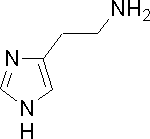Histamine
Molecular Structure:
MDL:
MFCD00005210
Molecular Formula:
C5H9N3
Molecular Weight:
115.15
Alias:
組織胺��,β-氨乙基咪唑,1H-咪唑-4-乙胺
2-(4-Imidazolyl)ethylamine
Product order:
| Name |
Specifications |
Packing |
Price |
Delivery |
| Histamine |
97% |
1g |
RMB 1193.5 |
Consulting service |
| Histamine |
97% |
5g |
RMB 5137 |
Consulting service |
Character:
無色針狀晶體。有吸濕性�����。在日光下易變質(zhì)���。組胺由組氨酸脫羧基形成,
熔點:83~84℃
沸點:167 °C/0.8 mmHg
廣泛分布在哺乳動物的組織中����,尤其在肥大細(xì)胞及有關(guān)嗜堿性白細(xì)胞內(nèi)(在變態(tài)反應(yīng)中肥大細(xì)胞釋放出組胺)?��?梢越M氨酚為原料發(fā)酵制得。它是變態(tài)反應(yīng)的藥理介質(zhì)��,能引起血管擴張�、毛細(xì)血管通透性增加、平滑肌收縮�����。支氣管平滑肌收縮能使動物呼吸困難���,并能刺激胃液分泌�����。在體內(nèi)����,組胺為組胺酶和咪唑-N-甲基轉(zhuǎn)羧酶所滅活。在中樞神經(jīng)系統(tǒng)中的某些部位����,特別是下丘腦含有組胺,它存在于突觸體內(nèi)�,可能是中樞神經(jīng)的一種介質(zhì)。它還可能與外周神經(jīng)的感覺及傳導(dǎo)有密切關(guān)系�����。以檢查胃的分泌機能����。可由組氨酸脫羧制成���。醫(yī)療上主要利用其促進胃酸分泌的作用�����。
Storage:
儲存溫度?20°C
內(nèi)源性H1 和 H2 組胺受體激動劑�;H1 激活并使Ca2+移動;H2 激活并刺激神經(jīng)元中腺苷酸環(huán)化酶(adenylate cyclase)活性����;激活NO合成酶;血管擴張劑�����。
Related Products
- N-Ethyl-p-menthane-3-carboxamide
- Cyanamide
- (R)-(+)-2-Methyl-2-propanesulfinamide
- N-(2-Hydroxyethyl)acrylamide, HEAA
- (S)-(+)-1,2,3,4-Tetrahydro-1-naphthylamine
- 3-Isopropylaniline
- N,N′-Methylenebis(acrylamide)
- 1-Naphthylmethylamine
- 2-Chloroacetamide
- 6-Aminonicotinamide
- Triacetonediamine
- Ciclopirox olamine
- N-Boc-ethylenediamine
- Dodecylamine
- 4-(Trifluoromethyl)benzylamine
- Histamine
- Methoxypolyethylene glycol amine
- 2-Bromo-5-fluoroaniline
- 2,4,6-Trimethylaniline
- Acetamide
- N-Methyl-1-(methylthio)-2-nitroethylen-1-amine
- Ethylene imine polymer
- (S,S)-(+)-N,N′-Bis(3,5-di-tert-butylsalicylidene)-1,2-cyclohexanediamine
- N,N-Dimethyldodecylamine N-oxide
- (S)-(+)-2,2-Dimethylcyclopropanecarboxamide
- Nonylamine
- Polyacrylamide
- m-Phenylenediamine-15N2
- Anthranilamide
- Tris(3,6-dioxaheptyl)amine
- N,N-Dimethylbutylamine
- Flunixin meglumin
- Formamide
- 1,2,3,4-Tetrahydro-1-naphthylamine
- N-Benzylacetoacetamide
- Diacetone Acrylamide
- N,N-Diethylhydroxylamine
- 3-(Dibutylamino)propylamine
- 3-Methoxybenzylamine
- 2-(p-Tolyl)ethylamine
- Tris(2-aminoethyl)amine
- Triethanolamine
- 4-Nitrobenzenesulfonamide
- 2,5-Diethoxyaniline
- 4-Bromotriphenylamine
- Cyanoacetamide
- L-Glutamic acid γ-(β-naphthylamide)
- 5-Bromo-2-thiophenesulfonamide
- N,N,N,N-Tetraacetylethylenediamine
- Sulfaguanidine
- N,N'-Di-sec-butyl-p-phenylenediamine
- 3-Lauryloxypropyl-1-amine
- 2,5-Dichlorothiophene-3-sulfonamide
- N-Benzylisopropylamine
- Tetra-N-phenylbenzidine
- Decylamine
- N-Hydroxy-5-norbornene-2.3-dicarboxylic imide
- Triisooctylamine
- 3,5-Dimethoxyaniline
- N-(2-Cyanoethyl)-N-ethylaniline
- 2-Chloro-6-fluoroaniline
- N-Phenyl-bis(trifluoromethanesulfonimide)
- 2,6-Dichloroquinone-4-chloroimide
- 2-Methyl-3-(trifluoromethyl)aniline
- 3-Chloro-2-methylaniline
- N,N-Dimethylethylamine
- 4-Bromo-2-fluoroaniline
- 3-Dimethylaminophenol
- 4-Hydroxytamoxifen
- 2-Methylcyclohexylamine(cis + trans)
- (1R,2R)-(?)-1,2-Diaminocyclohexane
- Bis(trifluoromethane)sulfonimide
- L-Glutamine-15N2
- (S)-(?)-α,4-Dimethylbenzylamine
- N,N-Dibenzylhydroxylamine
- Cysteamine
- 4-Methyl-1-naphthaleneboronic acid
- Oleylamine
- Ethanamine
- 2,6-Dichloro-4-trifluoromethylaniline





 滬公網(wǎng)安備 31012002003055號
滬公網(wǎng)安備 31012002003055號